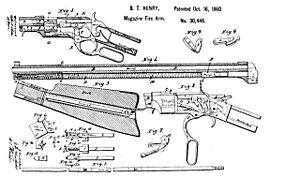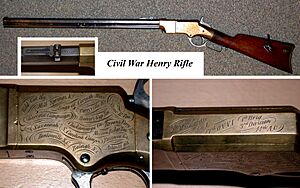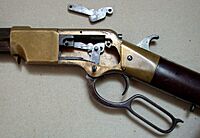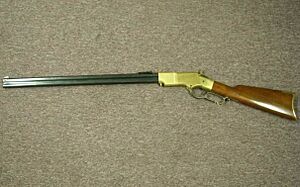Henry rifle facts for kids
Quick facts for kids Henry rifle |
|
|---|---|
 |
|
| Type | Lever-action rifle |
| Place of origin | United States |
| Service history | |
| Used by | United States, Confederate States, Native Americans, Mexico, Poland |
| Wars | American Civil War, Indian Wars, Second Franco-Mexican War, January Uprising |
| Production history | |
| Designer | Benjamin Tyler Henry |
| Designed | 1860 |
| Manufacturer | New Haven Arms Company |
| Unit cost | $40 (equivalent to $1,303 in 2022) |
| Produced | 1860–1866 |
| No. built | ~14,000 |
| Specifications | |
| Mass | 9 lb 4 oz (4.2 kg) |
| Length | 44.75 in (113.7 cm) |
| Barrel length | 24 in (61 cm) |
|
|
|
| Caliber | .44 Henry rimfire |
| Action | Breech-loading lever action |
| Feed system | 15-round tubular magazine |
The Henry repeating rifle is a special type of rifle that uses a "lever-action" system. This means you operate a lever to load new bullets. It also has a "tubular magazine," which is a long tube under the barrel that holds many bullets. This rifle became famous for its use in the Battle of the Little Bighorn. It also inspired the well-known Winchester rifle, often seen in stories about the American Wild West.
Benjamin Tyler Henry designed this rifle in 1860. The first Henry rifles could hold sixteen .44 caliber bullets. They were made from 1860 to 1866 by the New Haven Arms Company in the United States. During the American Civil War, the Union Army bought some Henry rifles. Soldiers liked them because they could fire much faster than other rifles. Later, many Henry rifles made their way to the American West. Some Sioux and Cheyenne warriors used them when they defeated George Armstrong Custer's U.S. Cavalry troops in June 1876 at the Battle of the Little Bighorn.
Today, companies like A. Uberti and Henry Repeating Arms make modern versions of the Henry rifle.
Contents
History of the Henry Rifle
The original Henry rifle was designed by Benjamin Tyler Henry in 1860. He worked on the design for three years. This rifle was an improved version of an earlier gun called the Volcanic. The Henry rifle used special copper (and later brass) cartridges. These cartridges held a bullet and black powder.
At first, only about 150 to 200 Henry rifles were made each month. By 1864, production increased to about 290 rifles per month. When production stopped in 1866, around 14,000 Henry rifles had been made.
The Henry Rifle in the Civil War
Owning a Henry rifle was a source of pride for soldiers during the American Civil War. The government only bought about 1,731 of these rifles. However, many soldiers bought their own Henry rifles. They often used their reenlistment money to buy them. About 6,000 to 7,000 Henry rifles were used by Union soldiers. Most of these soldiers were part of General Sherman's troops in the Western states.
The Henry rifle could fire very quickly compared to other weapons of that time. Soldiers believed that buying one could help save their lives. Because of their fast firing, Henry rifles were often used by scouts, skirmishers, and raiding parties. They were not usually used in large infantry formations.
A Confederate officer named John S. Mosby once called the Henry rifle "that damned Yankee rifle that can be loaded on Sunday and fired all week." This phrase became famous. Confederate soldiers who captured Henry rifles often had trouble finding the right ammunition for them. So, the rifle was not widely used by Confederate forces. However, some Confederate units in Louisiana, Texas, and Virginia did use them. Even the bodyguards of Confederate President Jefferson Davis were known to use Henry rifles. Experts say that one person with a Henry rifle had the firepower of 14 or 15 people with single-shot guns.
Other Conflicts
Forces led by Benito Juárez in Mexico got some Henry rifles during their war against the French.
It is also thought that the Henry rifle might have been used in the January Uprising in Poland. Some historical records mention a 16-shot rifle being used in battles there.
How the Henry Rifle Works
The Henry rifle used a .44 caliber cartridge. This cartridge had less power than bullets used in other rifles of that time, like the Spencer rifle.
When you pushed the lever down, it would eject the empty cartridge and prepare the hammer to fire. A spring in the magazine would then push the next bullet into place. When you moved the lever back up, it pushed the new bullet into the firing chamber.
To load the rifle, you would slide a part called the "cartridge-follower" along a slot. Then you would pivot it to the side to open the front of the magazine tube. You could then load up to 15 cartridges one by one. After loading, you would pivot the top part back and release the follower.
Lasting Impact of the Henry Rifle
Even though the Henry rifle was not given to all soldiers, it showed how powerful rapid-fire weapons could be. This was seen in the American Civil War and later in conflicts between the United States and Native American tribes. For example, two Union regiments armed with Henry rifles were very successful at the Battle of Franklin. Also, the Henry-armed Sioux and Cheyenne warriors defeated the 7th Cavalry at the Battle of the Little Bighorn.
The Henry rifle was made by the New Haven Arms Company. This company later developed the famous Winchester Model 1866 lever-action rifle. When the new Model 1866 was introduced, the company changed its name to the Winchester Repeating Arms Company.
Modern Copies
The company Henry Repeating Arms makes a modern version of the Henry Model 1860 rifle. It looks like the original with a brass receiver and a walnut wood stock. However, it has a modern steel barrel and updated internal parts.
Another company, Uberti, makes a very close copy of the Henry Model 1860. These replicas are popular with people who participate in Cowboy Action Shooting and Civil War reenactments.
See also
- Rifles in the American Civil War
- Spencer repeating rifle
- Winchester rifle







